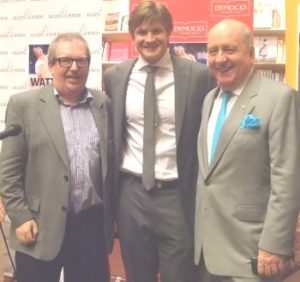BOOKS: A long and winding road
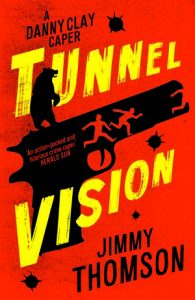 I was 14 years old when I read my first work of grown-up
I was 14 years old when I read my first work of grown-up fiction (Leslie Thomas’ The Virgin Soldiers) and decided that was what I wanted to do with my life. It only took 50 years to achieve that ambition of writing (hopefully) entertaining novels, although I’ve written a stack of other books in between.
fiction (Leslie Thomas’ The Virgin Soldiers) and decided that was what I wanted to do with my life. It only took 50 years to achieve that ambition of writing (hopefully) entertaining novels, although I’ve written a stack of other books in between.
At time of writing (July 2023) I have written 18 books and had 17 of them published, with Mole Creek, due out on August 1, on Echo Books.
Prior to that, in 2018, Affirm Press published Tunnel Vision, the second of my Danny Clay trilogy – hey, I can dream! By the way, I write all this not to boast, but to encourage other writers to keep going, even when the odds seem stacked against them.
Writing Tunnel Vision was interesting because the previous novel, Perfect Criminals, had taken about three years to write, on and off (mostly off). It had begun as an idea which I then used for the 20,000 word submission that got me my MA (Writing).
Having written 25 per cent of the number of words required for an average commercial novel, I decided to keep going but when it was finished, the search for a publisher was so frustrating that I briefly had it up on Amazon as a “Publish on Demand” and ebook publication.
However, just when I was ready to give up, Affirm Press came along and I had a two-book deal for not very much money. But I had a deal.
More importantly, I had a strong idea for where I wanted to take these characters and I knew how to pace the book so I wouldn’t have to cut 13,000 words out, as I did with the first one.
Having decided to set it in Saigon, I realised that, although I know the city pretty well, I needed to spend some time there being neither a tourist nor a tour guide – both of which I have done a lot.
So I spent two weeks just scuffing around Saigon, doing the occasional tourist trips – like street food tours on the back of motorbikes – while visiting parts of the city that Westerners are advised to avoid.
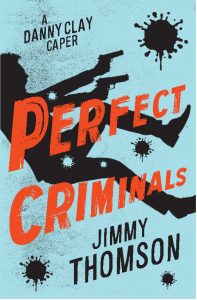
All the time, I was writing and as a result, Tunnel Vision took only three or four months to finish and it benefited greatly from that sense of immediacy and urgency (I think). Anyway, it’s a better book and I hope you get the chance to read and enjoy it. Click here if you want to buy it online from Abbey’s Books.
Its predecessor, Perfect Criminals, is a crazy romp through television and crime by my hero Danny Clay, a former army engineer turned scriptwriter. I tell people both books are written in the style of Carl Hiaasen. I know, I should be half as talented.
Anyway, it was something I didn’t even realise I was doing until I rewarded myself for finishing the book by reading his latest novel. Aha! So that’s what I was trying to do.
A reviewer in the Sydney Morning Herald said Perfect Criminals was “punchily written, packed with hard-boiled humour [and] a ride into the underbelly of the entertainment industry.” Another review in the Melbourne Herald-Sun said “an action-packed and hilarious crime caper, navigating its way through the dark side of the entertainment industry here and abroad.”
You can judge for yourself by buying a print copy (if you can still find one) or ebook here in Australia or on Amazon elsewhere.
My previously published books include two sporting biographies, two books about sappers (Army engineers) in Vietnam, one about sappers in Afghanistan, one memoir about my co-writer Sandy MacGregor (who introduced me to the sapper stories), and one true crime book which turned out to be too true for someone’s comfort.
There are also two illustrated children’s books, a book about apartment living and another about 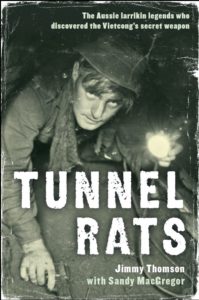 buying and selling real estate, and two self-help/inspirational books that I wrote for my former agent (and from which I have been edging away for years, on the grounds that I am the least qualified person I know to give anyone life advice).
buying and selling real estate, and two self-help/inspirational books that I wrote for my former agent (and from which I have been edging away for years, on the grounds that I am the least qualified person I know to give anyone life advice).
The 17th book – the unpublishable rather than unpublished one – was my first attempt at a novel about 25 years ago. I gave up after my first rejection slip. I am a bit more tenacious these days.
The new book, Mole Creek, had a much longer gestation than the other books and started life as a sprawling political novel set in the USA. It was only when I realised that the “McGuffin”, the device that motivated the plot, was actually what the book was all about, and I cut it back by about 50 percent and relocated it to Tasmania, that I got it published.
You can find out more about all previously published books by going to this page and clicking on the links.
Vietnam Romance and Intrigue
Ever since I led my first tour to Vietnam I have had this sneaking sense of unease. I don’t at all understand why the Australian government so willingly joined America’s war in Vietnam but I do get why Australian troops went there, especially the ‘Nashos” (National Servicemen).
Britain decided not to get involved (we had a Labour government at the time) but since we Brits had basically created the bloody mess by handing the country back to the French, rather than the Vietnamese, at the end of World War II, our hands aren’t exactly unbloodied.
Another thing that intrigues me is why so many Vietnamese (especially in the south) are so welcoming of Australian tourists. But I suppose a story told by someone I met on my second visit kind of sums it up. His father and Grandfather had fought on opposite sides in the “American War”. When the south fell to the Viet Cong, the father was evacuated out, leaving his family, and given a new life in the USA.
Years later, the father came back to Saigon and the grandfather came south from Hanoi to see his son again. It was a meeting they both longed for and dreaded. But then the grandfather said: “We both fought for what we believed in and that’s all that matters.”
My next tour, Vietnam Romance and Intrigue, will try to see beyond the battlefields and bravado. Sure we’ll see the tunnels at Cu Chi – we know their story better than most – but we’ll also visit families in Saigon and Hanoi to find out how they are living now.
Mainly we’ll be following inthe footsteps of Graham Greene and his novel The Quiet American, visiting the locations in the book as well as the 2001 Phil Noyce directed Michael Caine move, and soaking up the splendours of Ha Long Bay as deepicted so spectaculalrly in the 1992 film Indochine (starring Catherine Deneuve) .
It’s a varied itinerary and you can find out more by clicking HERE.
Wendell Sailor: Crossing The Line
Late last year (2012) I was just getting to grips with my latest project, a first person 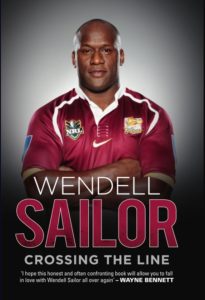 biography of sports star Wendell Sailor. I was chatting about our work with my partner, Sue Williams. She was working on her biography of father Bob Maguire and we joked about how you haven’t really got through to your subject until you can make them cry. We wished each other luck on that front, given that we were both dealing with very tough nuts.
biography of sports star Wendell Sailor. I was chatting about our work with my partner, Sue Williams. She was working on her biography of father Bob Maguire and we joked about how you haven’t really got through to your subject until you can make them cry. We wished each other luck on that front, given that we were both dealing with very tough nuts.
The very next day, Wendell was sitting in my home, sobbing his heart out. His wife, Tara, had read the first few chapters of the book (which I thought were pretty good anyway) and had pulled Wendell up. “I thought we agreed if you were going to do this, you were going to do this properly?” she’d said. “I though you were going to tell the whole story!”
And the next day I discovered why it had been so hard for Wendell to be honest about his past and why he had developed his happy-go-lucky, big boofy bloke shell. As he told me about his mother having given him up when he was two days old to neighbours who were as poor as church mice. He described how they never hesitated to make whatever sacrifices were necessary to allow him to pursue his dreams. He sobbed as he told me how his beloved father – the man who took him in when his own mother didn’t want him – had died without Wendell having a chance to tell him how grateful he was.
It was then that I knew we had a book that was different from any standard sporting biography. This was a story about struggle, sacrifice, stuff-ups and ultimately redemption.
I won’t tell you any more because I’d like you to read the book But here, to give you a little more of the flavour, here’s the publisher’s blurb. And if you want to buy the book, click HERE.
A warts-and-all insight into a sporting hero’s very public fall from grace and his comeback to elite sport.
Superstar Brisbane Broncos and Kangaroos winger Wendell Sailor shocked everyone when he switched codes to play union in 2001. The King of the Wing, the huge explosive player whose thunderous runs intimidated anyone in his path, surprised even himself when he went on from the Queensland Reds to be selected for the Wallabies, becoming the first Australian player raised in league to represent his country in both codes.
But in 2006, all of this fell apart.
During a routine drug test for his new team, the Waratahs, he tested positive to cocaine and was banned from the game for two years. And those two years away would prove to the toughest challenge of his life. The self-confessed party boy who constantly sought the public spotlight was now forced to do some soul-searching, and most of it wasn’t pretty.
But in the way that only Sailor can, he fought back hard and worked through the shame. Pitting himself against his old ways, Sailor threw himself into charity work, mentoring young people in alcohol and drug awareness programs and, with the help of his family and old coach and mentor, Wayne Bennett, began his path to redemption.
When the ban was up, Sailor made a triumphant return to the code that had first discovered him at age 17, and the St George Illawarra Dragons had a new winger – a player ferociously determined to prove to Australia what he was capable of until his final game in 2010.
But this isn’t just Wendell Sailor’s story as the comeback king. Written with Jimmy Thomson, Dell reveals a dark secret that has haunted him since childhood and goes to the very core of his identity. He tells us what it’s like to be a black man in a white man’s world and the toll racism takes on elite sport. He also shows us how good friends and mentorship are so important to our public national heroes. But he also demonstrates how crucial the bonds of family – and the love and trust of good people – are for anyone, hero or not.
About Wendell Sailor
Wendell Sailor exploded into the national rugby league competition at age 17 for the Brisbane Broncos under coach Wayne Bennett. From 1993 to 2001 he was the Broncos’ star winger, earning him household name status for his size, speed and try-scoring prowess, his reinvention of the traditional wing position and his party-boy antics off the field.
Just one year into his professional career he was selected to play for the national NRL team, the Kangaroos, and represented his country – and his state in Origin football – til he made the controversial decision to swap codes and play union for the Queensland Reds in 2001. In 2003 Sailor became the first Australian league-raised player to become a dual international, when he was selected for the Wallabies in the World Cup and went on to represent his country until 2006, also the year he switched clubs to play for the New South Wales Waratahs.
That year would prove to be a disaster for Sailor, who was banned for two years from representing the Waratahs and the Wallabies for returning a positive drug test for cocaine. Those two years out of sport – any sport – saw Sailor hit rock bottom physically and emotionally before he pulled himself together and became heavily involved in charitable drug awareness programs and corporate speaking. In 2008 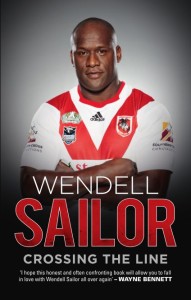 another shock announcement saw him signed back to the NRL, this time the St George Illawarra Dragons. In 2009 he would be reunited with his old Broncos coach, Wayne Bennett, who joined him at the Dragons.
another shock announcement saw him signed back to the NRL, this time the St George Illawarra Dragons. In 2009 he would be reunited with his old Broncos coach, Wayne Bennett, who joined him at the Dragons.
Sailor’s second coming in NRL saw his customary speed and strength on the field – in 2008 he was named in the Indigenous Australia squad for the Rugby World Cup, in 2009 he was influential in the Dragons’ Minor Premiership and was short-listed for the Dally M Winger of the Year award. Sailor announced his retirement from the Dragons at the end of the 2009 season and his final match was in 2010, for the Indigenous All Stars, during which he scored the opening try.
Sailor went on to a career in television both as a football commentator and as a participant in entertainment programs. He is a promising rugby league coach, an obsessive golfer and a tireless charity worker.
Tunnel Rats
 Allen & Unwin published Tunnel Rats at the beginning of July 2011. It’s a major rewrite of ‘No Need For Heroes’ the first-person memoir I wrote for Sandy MacGregor about 15 years before, but updated and re-tooled as a full-blown military history rather than a personal memoir. It’s a real “Boys’ Own” adventure – only for grown-up boys – telling the story of the young Australian Army engineers who, when they weren’t having a whale of a time, often at their own officers’ expense, were the first Allied troops to go down the Vietcong tunnels and discovered their underground city.
Allen & Unwin published Tunnel Rats at the beginning of July 2011. It’s a major rewrite of ‘No Need For Heroes’ the first-person memoir I wrote for Sandy MacGregor about 15 years before, but updated and re-tooled as a full-blown military history rather than a personal memoir. It’s a real “Boys’ Own” adventure – only for grown-up boys – telling the story of the young Australian Army engineers who, when they weren’t having a whale of a time, often at their own officers’ expense, were the first Allied troops to go down the Vietcong tunnels and discovered their underground city.
What I love about this story – and what made me want to go back and rework it after all this time – is that these guys were not only genuinely courageous and endlessly resourceful, they had a spirit of adventure and mischief that sustained them through what was a pretty horrific time. There are plenty of outrageous stories like the time they booby-trapped their own shower block – which they had built with money from their own little casino – rather than let it fall into the hands of recently arrived officers; then there was the ‘car chase’ through the streets of Saigon in which two sappers evaded the combined might of the US, Australian and South Vietnamese military police by commandeering a tuk-tuk and, ultimately, driving it under the barrier gate of their camp.
There was the investigation of the Tunnels, of course and the discovery of the underground city – they were the first Allied troops to venture down there, regardless of who lays claim to that honour. And then there was the day-to-day engineering tasks that varied from building bridges to “de-lousing” booby-trapped rice caches, embodying their unofficial motto Facimus et Frangimus – we make and we break.
Tunnel Rats went into reprint in only its first week on sale and has been selling well in various formats since. The follow-up book A Sappers War was published in 2012. It traces the involvement of Australian Army engineers in Vietnam from the start of the “American War’ – before Australia’s official involvement – to the very last convoy out of the country.
Meanwhile, you can listen to an interview with Sandy and me on Radio National, with Geraldine Doogue, HERE, read an extract (as a PDF) HERE, or buy the book, either as a paperback or an eBook HERE.
Apartment Living
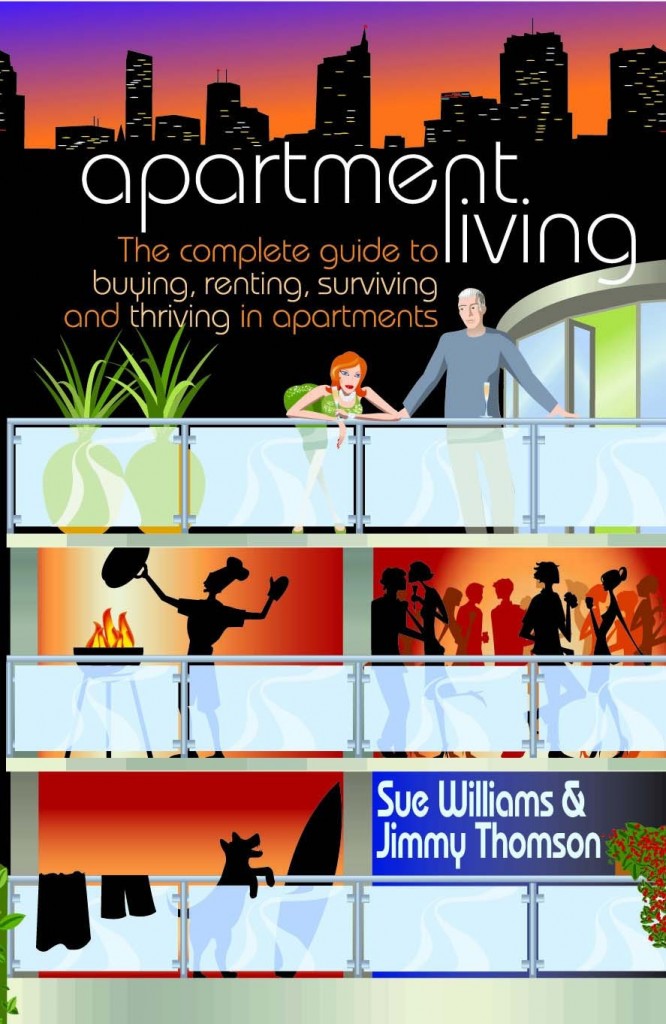
Apartment Living was written by my partner Sue Williams and me in response to the fairly troubled times we faced when we first moved into a new apartment block in Sydney.
We ran the whole gauntlet of issues, from a dodgy Executive Committee the chair of which was a little too autocratic and close to the developers for comfort, to a building manager – also employed by the developers – who was not only utterly incompetent but ran nasty little vendettas against any residents who dared to criticise the way the building was being run.
It took a group of committed owners nine months to resolve this scandalous situation, sack the original EC and the building manager and get things running smoothly (for which I can take no credit).
Both being writers, our instinctive response was to get it down on paper and make some of the stuff that we’d discovered available to others. We also tried to make the book as entertaining and informative as we could.
It was published by ABC Books in June 2004 and one reviewer for The Age in Melbourne called it “The Lonely Planet for apartments” which was just about the feel we were looking for.
many of the laws referred to in the book have changes and are about to change even more in 2014 when the new NSW strta laws come in. I plan to have a new version of the book available then. Check the Flat Chat website for updates.
No Need For Heroes
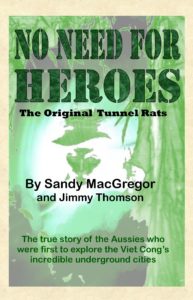 After the Koala Who Bounced was finished, my agent Selwa Anthony put me with a former Australian army major called Sandy MacGregor who won the Military Cross for his exploits in the Vietnam War.
After the Koala Who Bounced was finished, my agent Selwa Anthony put me with a former Australian army major called Sandy MacGregor who won the Military Cross for his exploits in the Vietnam War.
His men in 3 Field Troop were the first to go down the and explore the incredibly complex Viet Cong tunnel systems. The Americans intially just blew them up until Sandy’s guys discovered these underground cities. The name Tunnel Rats rightly belongs, originally, at least, the the men of 3 Field Troop.
The resulting book was called “No Need For Heroes” and it details the adventures of his whole troop. The book was a bit unsatisfactory because I was trying to write in Sandy’s voice while I had found a rip-roaring tale in the “Virgin Soldiers” vein that I wanted to tell in my own way.
The result is a bit bi-polar and Sandy and the guys of 3 Field Troop deserved better. Just as soon as the mainstream here loses it’s paranoia about Vietnam, I might use my notes from all the interviews I did as the basis for a novel. By the way, the cover shown here is for the re-issued version and I designed as a favour for Sandy. I reckon it looks OK. And it was only very recently that I realised I must have subconsciously stolen the tile from the lyrics of the Cold Chisel song Khe San.
I have a few copies of No Need … (with the old cover) available for $25 including postage. Use this Paypal button and we’ll get a copy to you.
The Ultimate Guide …
 Our first book about living in apartments , ingeniously called Apartment Living, led to my weekly Flat Chat column in the Sydney Morning Herald. Ironically, based on the column, Fairfax Publications invited me to write The Ultimate Guide to Buying and Renting Houses and Apartments which is a much more practical and down-to-earth “how-to” book about buying, selling and renting – although it does have a “Best and Worst of Flat Chat” included.
Our first book about living in apartments , ingeniously called Apartment Living, led to my weekly Flat Chat column in the Sydney Morning Herald. Ironically, based on the column, Fairfax Publications invited me to write The Ultimate Guide to Buying and Renting Houses and Apartments which is a much more practical and down-to-earth “how-to” book about buying, selling and renting – although it does have a “Best and Worst of Flat Chat” included.
The Ultimate Guide to was published in June 2006 and updated in April 2008 (rrp $29.95).
The Ultimate Guide … is currently out of print but I am writing an update to Apartment Living.
The first Tunnel Rats tour
In February 2012, Sandy MacGregor and I, as co-authors of the best-selling military adventure Tunnel Rats, led a select group of travellers to where Aussie troops were based in Vietnam, working hard, playing harder, and creating the legend of the Tunnel Rats.
That tour, which had guests ranging from young blokes in their 20s to one lady in her 70s, was a huge success. Not so much a tour for former for former Tunnel Rats this was for those who’d read the book or heard some of the stories and want to see for themselves. Led by Sandy and me, the group followed the Tunnel Rat trail from the tunnels of Cu Chi to the former base at Nui Dat and from the beaches of Vung Tau to the nightspots of Saigon.
Sandy and I are both experienced and, dare I say it, entertaining public speakers on a variety of topics. I was happy to talk about writing Tunnel Rats and its sequel A Sappers War, as well as my other writing exploits. But Sandy was what made this trip unique.
As a young Army Engineer, Sandy commanded 3 Field Troop, and he was the one who decided they should go down the tunnels and investigate what was there (when Americam troops were specifically forbidden from doing so), making them the original Tunnel Rats. Sandy was awarded the Military Cross for his leadership and achievements.
We were lucky to be joined by author and journalist Mark Dapin who was researching his own book, as a well as a feature on Sandy for Good Weekend magazine which you can read HERE.
Our first trip blazed the trail and included some unexpected discoveries that filled our days (but ate into our downtime). Two of our guests wrote a piece for their local paper – you can read that HERE.
I am organising another tour which will take in the tunnels (of course) but is also looking at Vietnam and its people today. I’m calling it Vietnam: Then and Now and we are putting together a package that should interest travellers of any inclination.
And Sandy and I are working with Military History Tours too create a programme that is much more focussed on the American War (as it is called in Vietnam) and you can read about that here.
The Koala Who Bounced … and kept bouncing
Karri the Koala came to life when the artist/cartoonist Eric Lobbecke asked my wife Sue if he she would write a kids book for him to illustrate. For some reason she suggested that he and I collaborate and meantime she introduced us to Selwa Anthony whose writer management agency was just getting going. With Selwa’s help we produced a kids book together called “The Koala Who Bounced”.
It took me six days to write and Eric six months to draw but we get equal shares of the royalties. How can that be fair? I even get top billing. I wish I could draw as well as Eric – actually, I wish I could write as well as Eric draws.
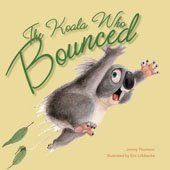
Eric is now writing his own stories but we still get cheques for that book every six months and it has even been translated into Korean. Why? Maybe someone thought it should be translated into Koalean and something got lost in translation. Anyway, thanks Eric and Selwa – our little bouncing koala has done us proud.
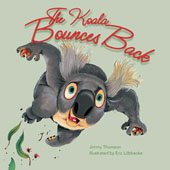 In 2011, Eric and I wrote and illustrated the follow-up The Koala Bounces Back which never really caushgt the public imagination the same way (despite, or possibly because of, its hidden message about refugees (and football)
In 2011, Eric and I wrote and illustrated the follow-up The Koala Bounces Back which never really caushgt the public imagination the same way (despite, or possibly because of, its hidden message about refugees (and football)
But Karri is still bouncing around and who knows where he might show up next.
Watto
I often joke that the reason I came to live in Australia was so I could support an international Test team that wasn’t England. That’s a bit of an exaggeration but there would be an element of truth in that for any cricket-loving Scot. 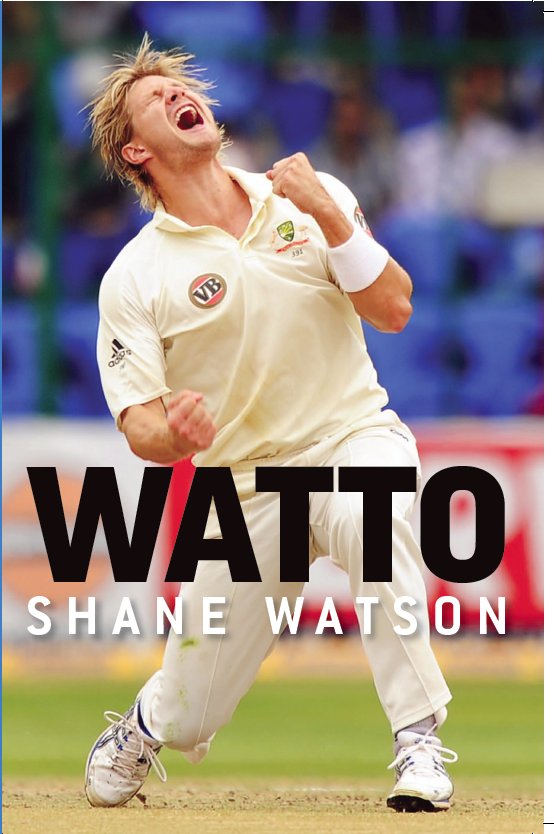
Now, to be fair, Shane would be the first to admit that he’s a bit young to have his life story written – but that doesn’t mean he doesn’t have a story worth telling. His battle back from being the player most likely to be out with injury to the first name on the team sheet is inspiring and compelling (and that’s without my help).
He wasn’t even 12 years old when he got his first back injury although it’s hardly surprising, given he was playing rugby union, rugby league and cricket at the time. Eventually, the other sports had to give way as he tried to build and strengthen his young body. A process that has often been misrepresented as vanity was really the results of his efforts to ward off injuries that had plagued him from an early age.
What he couldn’t have known was that all those hours in the gym were the worst thing he could have done. One observer said he was “too strong for his body” and while he scoffed at that at the time, he would later learn that there was a lot of truth in that comment. Physio Victor Popov was the first to suggest that he needed to build his core rather than his bi’s, tri’s and thighs.
It took a lot of courage and determination to turn his back on the traditional view of team medics and take his own route to fitness. However he had been advised that the only cure for his recurring back injuries was to give up bowling.
At the time of publication, Shane had been recovering from his first fitness issues for years but, as we now know, his bowling had to be managed carefully – not too little and definitely not too much – for him to be able to give his absolute best for club, state and country.
Commentators like Peter FitzSimons and Alan Jones have both praised the book – and whatever you might think of Jones’ political views, the former Australian rugby coach knows his sport.
Despite snide and ill-informed comments that Watto was a quick, exploitative knock-off (hey, Cricinfo, if you can’t get basic facts right, what are you any good for?), this book was 18-months in the making and many hours revising and reviewing material – often with the help of Skype when Shane was in India – made sure this was Shane’s story, in his voice with the slightest non-Shane phrases removed. For instance, I had no idea that he never refers to the No 3 batsman as ‘first drop” but he soon put me right.
My contribution was to prod and probe and try to get to the heart of the man then set my ego aside and write it so that it was his personality that came across (rather than mine). The greatest compliment paid to the book was his sister Nicky telling me that when she was reading it she could hear his voice in her head.
One thing I did contribute was the idea of “drinks breaks” – little sections of insight where Shane explained everything from how reverse swing works (and how to get it) to the design of bats. At one point the publishers even thought of extracting them and publishing them separately but it was decided to keep the book together and provide better value for money.
Unlike many sports books, it’s not full of stats or lists. It’s a rare insight into the thinking of a top-class sportsman (and one of the most decent human beings I’ve ever met). For my part, considering I’d just written Snitch about the underworld in Kings Cross, I think Shane was pleasantly surprised that I knew the difference between a full toss and a happy ending.
You can buy Watto online HERE.
